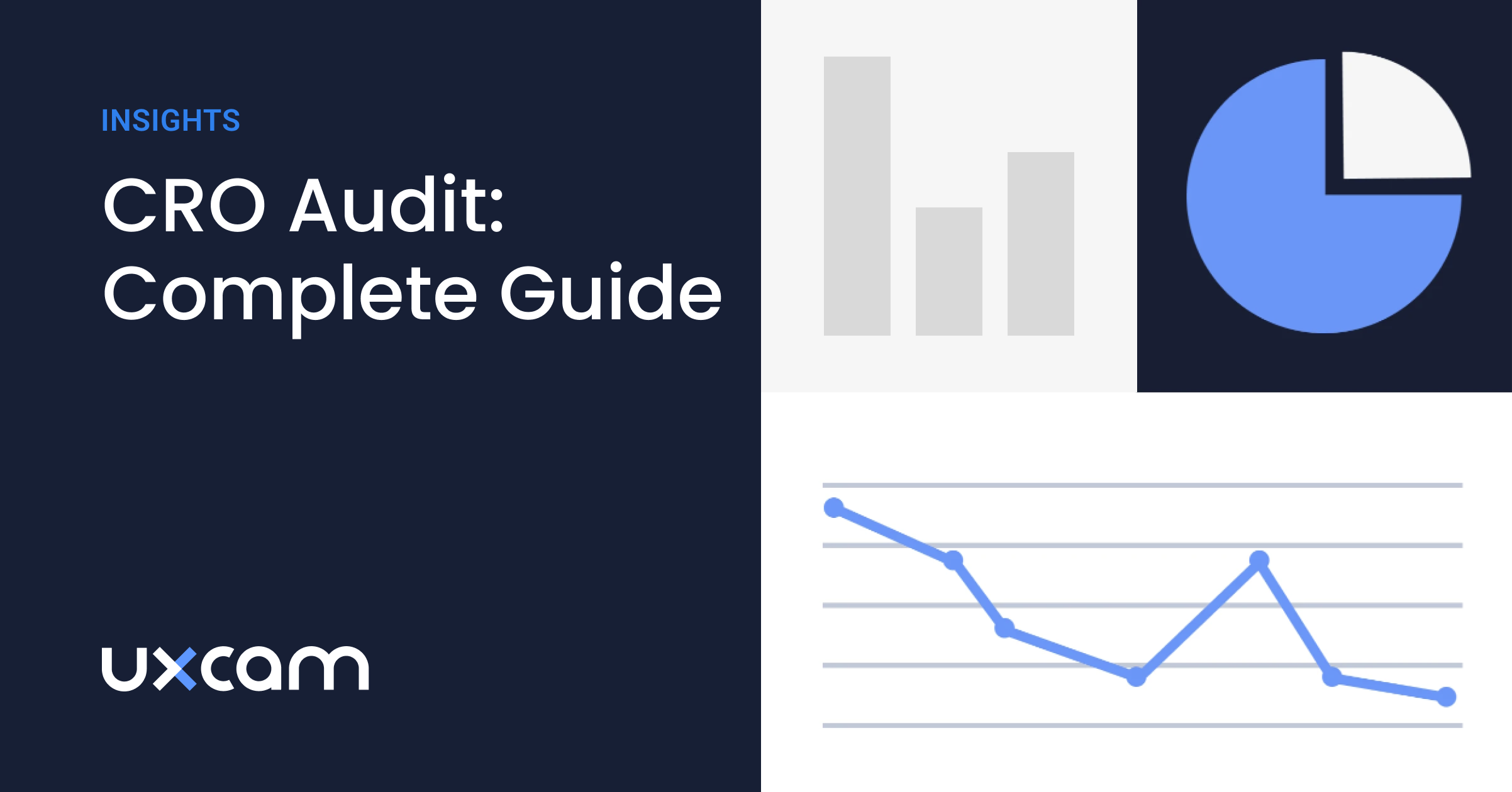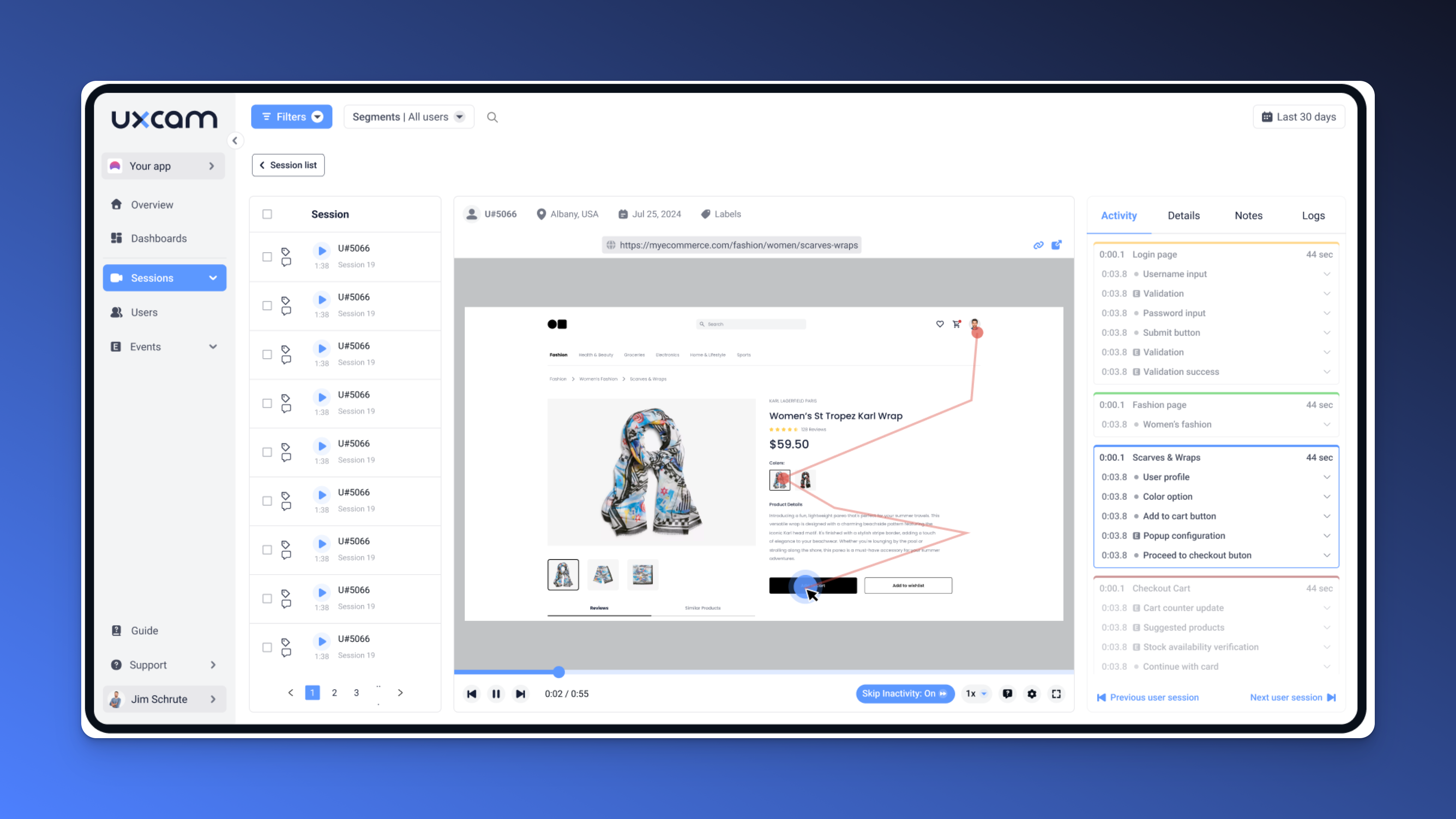Back to blog
14 MIN READ
Conversion Rate Optimization Audit: Complete Guide
PUBLISHED
8 February, 2025

Growth Lead

Converting visitors into customers is the lifeblood of any online business. Yet many websites and apps struggle to turn traffic into tangible results. This is where a conversion rate optimization audit comes in. A CRO audit is “a comprehensive review designed to identify barriers that prevent visitors from completing conversion actions” (mailchimp.com).
In simple terms, it’s a thorough inspection of your site or app to find out what’s stopping users from converting – and how to fix it. In this article, we’ll explore why CRO is so important for websites and web apps, the telltale signs that you might need a CRO audit, the steps to conduct one, and how tools like UXCam can help boost your conversion rates.
Quick Summary
| Audit Step | Description |
|---|---|
| 1. Identify Key Metrics | Determine which metrics are critical for assessing conversion rate performance. |
| 2. Collect Data | Gather information using tools and analytics to understand user behavior and patterns. |
| 3. Identify Conversion Barriers and Hypothesize Causes | Based on the data, identify friction points and opportunities for improvement. |
| 4. Develop an Action Plan | Create a prioritized list of changes to test, focusing first on the areas likely to yield the biggest conversion lift. |
| 5. Test Your Changes | Testing takes the guesswork out of CRO by letting real user behavior validate your hypotheses. |
| 6. Iterate | A CRO audit is not a one-and-done task but rather the foundation of a continuous optimization cycle. |
Signs Your Website or App Needs a CRO Audit


How do you know if it’s time to perform a conversion rate optimization audit? Here are some common red flags and signs that your website or web app could benefit from a CRO audit:
High bounce rates: If a large portion of visitors leave after viewing just one page, it indicates an issue capturing their interest or meeting their expectations. For reference, a bounce rate above 70% is generally considered poor for most sites (blog.aspiration.marketing). High bounce rates can stem from slow load times, confusing design, or irrelevant content – all issues a CRO audit can uncover.
Low conversion or signup rates: This one is obvious – if only a tiny fraction of users convert (purchase, sign up, request a demo, etc.), something is impeding them. Many websites convert less than 1% of visitors into leads or customers. If your conversion rate is below industry benchmarks or has stagnated, it’s a clear sign you need to investigate why users aren’t taking action.
High cart abandonment (for e-commerce): People adding products to the cart but not completing the purchase is a classic signal of friction in the checkout process. The average cart abandonment rate is close to 70%, representing a huge chunk of potential revenue lost. If your cart abandonment is at or above this average (or climbing), a CRO audit can help identify whether the issue is unexpected costs, a complicated checkout, lack of trust signals, or something else.
Low engagement with CTAs and forms: Perhaps users are browsing but not clicking your calls-to-action (CTAs) or not completing key forms (contact forms, sign-ups). A low click-through rate on CTAs means visitors aren’t enticed to take the next step. If your newsletter sign-up or free trial form has many visitors starting but not finishing, that’s a sign of confusion or hesitation in the process. These behaviors hint that your messaging or UX isn’t effectively driving action.
Poor mobile experience metrics: Over half of web traffic now comes from mobile devices. If your mobile bounce rate is high, mobile conversion rate is much lower than desktop, or users complain about your mobile usability, you likely have a mobile UX problem. A site or app that isn’t mobile-friendly will alienate a large portion of your audience and miss out on valuable conversions. Consistency across devices is key – any friction on mobile is a cue for a CRO audit focusing on responsive design, load speed, and mobile UI.
Declining or stagnating conversions: If you notice your conversion rate has dropped recently or flatlined despite increasing traffic, it’s time to investigate. A downward trend could be due to new bugs, changes in user behavior, or competitors offering something more compelling. Even if conversions are steady but not growing with traffic, an audit can uncover growth opportunities you’re currently missing.
User feedback indicating issues: Qualitative signs matter too. Do you see users complaining about difficulty finding information, or saying things like “I tried to sign up but it didn’t work”? Frequent support tickets or feedback about confusing navigation, broken elements, or slow performance are strong indicators that parts of your experience are turning users away.
In short, if your website or app is underperforming in terms of turning visitors into customers – whether evidenced by metrics or user feedback – a CRO audit is likely overdue. It’s also wise to conduct an audit before major events like a big marketing campaign or a site redesign, so you can fix known issues beforehand and not amplify problems.
Steps to Conduct a Conversion Rate Optimization Audit
Performing a CRO audit involves a systematic, data-driven approach to find and fix conversion blockers. Here are the key steps to conduct a successful conversion rate optimization audit:
Define Your Goals and KPIs: Start by clearly identifying what “conversion” means for your site or app. Is it a product purchase, account signup, newsletter subscription, or something else? You may have primary conversions (e.g. purchases) and secondary conversions (e.g. add-to-cart or social shares). Define the key performance indicators (KPIs) you care about – such as conversion rate, click-through rate, bounce rate, average order value, etc. Having specific goals and metrics will guide your audit and make it easier to measure improvements. Also, establish benchmarks or industry averages for context. For example, knowing that the average conversion rate in your industry is X% helps you gauge where you stand.
Collect and Analyze User Data: A CRO audit begins with gathering data on how users currently behave on your site or app. Dive into your analytics platform to assess metrics like traffic sources, exit rates, funnel drop-off points, and page performance. Identify the pages or steps in the user journey with the highest exit or drop-off rates (for instance, a product page that many visitors leave without adding to cart, or a signup form where many quit halfway). Also look at user segments – are new visitors converting less than returning ones, is mobile performing worse than desktop, etc. Besides quantitative data, incorporate qualitative insights: use heatmaps and session recordings to see where users click or get confused, and run surveys or collect feedback to hear in their own words what issues they face. The goal in this step is to pinpoint where and when users are disengaging or getting frustrated. For example, analytics might show a form with a high exit rate, while session replay reveals users repeatedly clicking a disabled button – a clue that the form’s UX is flawed.
Identify Conversion Barriers and Hypothesize Causes: Based on the data, compile a list of problem areas that could be hurting your conversions. These might include specific pages (like a landing page with a high bounce rate), steps (like a checkout page with many abandons), or elements (like an unclear call-to-action). For each issue, form a hypothesis about why it’s happening. Put yourself in the user’s shoes and review the experience critically. Is the value proposition unclear? Is the page too slow? Is the navigation confusing? Are forms too long or asking for too much information? You might hypothesize, for instance, that “users abandon the signup because the process has too many steps” or “mobile users bounce because the content isn’t optimized for small screens.” Prioritize the issues by their potential impact – a broken payment step is a huge blocker, for example, whereas a minor typo in content is likely low impact.
Develop an Action Plan: With a list of hypotheses, outline possible solutions or improvements for each. This could range from small tweaks (like changing a button color or wording) to bigger changes (like redesigning a page layout or simplifying a multi-step form). At this stage, it’s useful to brainstorm multiple ideas and also look at best practices or what top-performing competitors are doing. Ensure your proposed changes are data-driven, directly addressing the problems you found. For example, if users aren’t clicking a CTA because it’s hard to find, a solution could be to make it larger, more prominent, or stickier on the page. If a particular field in a form causes drop-offs, you might remove or optionalize it. Create a prioritized list of changes to test, focusing first on the areas likely to yield the biggest conversion lift.
Test Your Changes: Rather than blindly implementing all changes at once, use A/B tests or other experimentation methods to validate what works. A/B testing involves creating a variation of a page or element (e.g., a new headline, a shorter form, a different layout) and splitting traffic between the original (Control) and the new version (Variant) to see which performs better. This step is crucial to ensure your improvements actually have a positive impact and don’t inadvertently hurt something else. Most successful companies run A/B tests regularly – in fact, 77% of companies run A/B testing on their website (loopexdigital.com) as a part of their optimization process. If A/B testing tools are available, test one change at a time to isolate its effect. If formal testing isn’t feasible, you can also deploy changes incrementally and monitor the metrics closely as a before-and-after comparison (though this is less scientific). Remember to gather enough data to reach statistical significance if possible. Testing takes the guesswork out of CRO by letting real user behavior validate your hypotheses.
Implement Data-Driven Improvements and Iterate: Once tests identify a winning change (or if the data clearly showed a problem and you fixed it), roll out the improvements to all users. Your conversion metrics should start to improve – but the process doesn’t end here. Use the new data to verify the impact and continue monitoring for any new friction points. Conversion optimization is an ongoing, iterative process. After implementing the first round of fixes, you may conduct another audit or move on to the next set of issues on your list. Over time, small gains compound: a 5% lift here, 10% lift there, can add up to major growth. It’s also important to document your findings and build a CRO knowledge base. This way, your team learns what works for your users and can continuously refine the user experience. In essence, a CRO audit is not a one-and-done task but rather the foundation of a continuous optimization cycle.
By following these steps – setting goals, analyzing user behavior, identifying issues, testing changes, and implementing improvements based on data – you create a feedback loop that steadily enhances your website or app’s performance. Every insight from the audit is an opportunity to remove an obstacle and smooth the path to conversion.
How UXCam Helps Optimize Conversion Rates


Conducting a CRO audit is much easier and more effective when you have the right tools to analyze user behavior. This is where UXCam comes into play. UXCam is a powerful analytics platform that helps you understand exactly how users interact with your mobile app or web app.
Here's a quick demo of UXCam:
It provides in-depth visibility into the user experience, which is invaluable for identifying conversion blockers. In fact, UXCam reveals user interactions and bottlenecks, improving app experiences and conversions”. Here are some key UXCam features that assist in analyzing and improving user experience during a CRO audit:
Session Replays: UXCam records user sessions so you can watch real playbacks of users navigating your app or site. This is like looking over a visitor’s shoulder as they scroll, tap, and attempt to use your interface. Session replays let you see where users hesitate, rage-click, or abandon a process. For example, you might observe multiple users repeatedly tapping an unresponsive element or getting stuck on a particular screen – clear evidence of a UX issue affecting conversions. By seeing exactly what the user saw and did, you can quickly pinpoint UI glitches, confusing layouts, or other hurdles that aren’t obvious from analytics alone.
Heatmaps and Gesture Analysis: UXCam automatically generates heatmaps that aggregate user interactions like taps, clicks, scrolls, and swipes. These visual overlays show which parts of a page or screen are getting attention and which are being ignored. Heatmaps can confirm if important calls-to-action are being seen and clicked or if users are misdirected by less important elements. For instance, a heatmap might reveal that users are trying to click an image or text that isn’t clickable – indicating a potential source of frustration. By understanding where users focus (and where they don’t), you can adjust the design to guide attention to the critical conversion elements. This helps in redesigning pages so that the visual hierarchy aligns with your conversion goals.
Funnel and Drop-off Analysis: With UXCam, you can set up funnels to track the steps users take toward a conversion (such as onboarding screens -> product page -> add to cart -> checkout). The tool will show you conversion rates at each step and where users drop off. This is incredibly useful for a CRO audit because it quantifies exactly which stage of your flow is losing the most users. If you see, for example, that 60% of users who add an item to cart don’t complete the purchase, you know to investigate the checkout process closely. UXCam’s funnel analytics provide these insights without requiring complex setup (it offers no-code setup for tracking events and screens). By identifying the biggest drop-off points, you can prioritize fixes that will have the biggest impact on overall conversion rate.
User Journey Analytics: Beyond predefined funnels, UXCam allows you to explore general user paths and behaviors. You can discover, for instance, the common paths users take before converting versus those who don’t convert. Maybe users who explore the pricing page are more likely to sign up – highlighting the importance of that page – whereas many users who visit your FAQ page leave afterwards, suggesting their questions weren’t answered. UXCam’s auto-captured data on user interactions helps you uncover these patterns and outliers, so you can better support the journeys that lead to conversion and address those that don’t.
Issue and Crash Reporting: Sometimes conversion issues are due to technical problems – a crash, an error, or a bug that prevents completion. UXCam includes issue analytics that surface app crashes or UI anomalies. If users are dropping off because the app crashed at a certain point or an error prevented form submission, UXCam will flag that. This ensures you’re not in the dark about technical issues affecting user experience. By fixing crashes or bugs, you remove these conversion blockers. (After all, no amount of UI tweaking will help if a critical step is broken.)
Tagless Analytics and Ease of Implementation: One of UXCam’s standout features is tagless auto-capture of user interactions. This means you don’t have to manually instrument every button or event in your app to collect data – UXCam automatically records taps, screen loads, and more. During a CRO audit, this is a huge advantage because you can retroactively analyze virtually any interaction without having set up tracking in advance. You won’t encounter gaps in your data just because you didn’t anticipate a certain user behavior. The ease of setup means you can get started on analysis quickly, focusing on insights rather than technical implementation.
Using UXCam as part of your CRO toolkit can make the audit process faster, more accurate, and more insightful. Instead of guessing why users behave a certain way, you get the evidence in recorded sessions and heatmaps. UXCam essentially lets you experience your product from the user’s perspective, which is critical for understanding and improving conversion drivers. It’s like having a continuous user testing lab running in the background, showing you where people get confused or frustrated. Armed with these insights, you can make targeted UX improvements: streamline a form, fix a flawed gesture control, reposition a call-to-action, etc. Such data-driven UX enhancements directly translate to higher conversion rates. In short, UXCam provides in-depth insights, heatmaps, and session recordings to help you optimize your app – exactly what you need to conduct an effective conversion rate optimization audit.
Why Conversion Rate Optimization Matters
Attracting visitors is only half the battle; if your site or app isn’t optimized to convert those visitors, you’re leaving money on the table. Conversion rate optimization focuses on making the most of the traffic you already have by improving the user experience and conversion funnel. Consider that the average website conversion rate is only about 3.7% (loopexdigital.com).
That means roughly 96 out of 100 visitors leave without taking the desired action. Top-performing websites, however, boast conversion rates of 11% or higher. The gap between average and best shows the enormous upside of optimization. Even a small uptick in conversion rate can significantly impact your revenue. For example, increasing conversion from 2% to 3% means a 50% increase in customers without any extra traffic.
CRO is also one of the most cost-efficient ways to grow your business. Instead of pouring budget into acquiring more visitors, optimizing your conversion funnel lets you maximize ROI from existing traffic. It’s no surprise that companies prioritize it: only 22% of businesses are satisfied with their conversion rates, and the rest see room for improvement. By investing in CRO, you can increase revenue and even decrease customer acquisition costs, since more of your current visitors turn into customers. In essence, CRO helps you do more with what you already have.
Importantly, conversion rate optimization goes hand-in-hand with user experience. The goal isn’t to trick users into clicking a button – it’s to make your website or app as clear, user-friendly, and persuasive as possible so that users naturally complete the actions that benefit both them and your business. A user-centric approach to CRO yields a win-win outcome: the user has a great experience and accomplishes their goal, and you gain a conversion. Optimizing things like page load times, navigation, content clarity, and mobile responsiveness not only boosts conversions but also improves customer satisfaction and loyalty in the long run.
Putting It All Together
Conversion rate optimization is important because it increases the value of the traffic and users you already have, making your marketing efforts more efficient and your users happier. A CRO audit is the first step in this continual process – it shines a light on the cracks in your conversion funnel, whether it’s a leaky signup flow, an underperforming landing page, or a troublesome mobile experience. By recognizing the signs that your website or app needs a CRO audit, you can address issues proactively before they erode your business results. And by following a structured audit process (goal setting, user behavior analysis, hypothesis, testing, and iterating improvements), you take the guesswork out of optimization and base your decisions on data and evidence.
The rewards of CRO are well worth the effort. Companies that embrace data-driven conversion optimization enjoy higher revenues, lower customer acquisition costs, and a competitive edge in user experience. Whether your conversion rate is 1% or 5%, there’s almost always room to improve – and even a modest improvement can boost your bottom line significantly. Remember that optimization isn’t a one-time project but an ongoing mindset. Continually test new ideas, listen to your users, and fine-tune the experience.
If you’re serious about improving your website or app’s performance, consider leveraging tools like UXCam to gain deep insight into user behavior. When you can watch users interact with your product and see where they struggle, you can fix issues faster and with confidence. Optimization becomes less of a shot in the dark and more of a science.
Ready to turn more visitors into customers? Don’t leave your conversion rate to chance. Conduct a conversion rate optimization audit and use a robust analytics tool to guide your improvements. Start your free trial of UXCam today and discover how actionable user experience insights can help you streamline your funnel, delight your users, and dramatically increase your conversion rates. Here’s to higher conversions and sustainable growth! You might also be related in these;
AUTHOR

Jonas Kurzweg
Growth Lead
What’s UXCam?
Related articles
Conversion Analysis
Flutter Session Replay & Recording for Apps: UXCam
Optimize your Flutter app's performance with UXCam's session recording and replay tool. Easy integration, optimized features, and strong...

Jonas Kurzweg
Growth Lead
Conversion Analysis
What is Mobile Analytics? Guide, Tools & Best Practices
Mobile analytics take the guesswork out of understanding how users interact with your app. Learn what mobile analytics is, why it's important, and how it differs from web...

Jonas Kurzweg
Growth Lead
Conversion Analysis
Mobile App Session Replay: Ultimate Guide 2025
Unleash the power of session...

Jonas Kurzweg
Growth Lead


